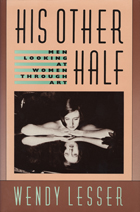
Wendy Lesser counters the reigning belief that male artists inevitably misrepresent women. She builds this daring case compellingly through inquiry into many unexpected and delightfully germane subjects—Marilyn Monroe’s walk, for instance, or dwarf manicurist Miss Mowcher in David Copperfield, or the shoulder blades of Degas’s bathers. Placing such particulars within the framework of Plato’s myth of the divided beings and psychoanalytic concepts of narcissism, Lesser sets out before us an art that responds to and even attempts to overcome division.
By following a developmental, rather than historical, sequence, the book uncovers startling correspondences and fresh insights. It begins by considering Dickens, Lawrence, Harold Brodkey, Peter Handke, and John Berger on the subject of mothers; turns to Degas and the Victorian novelist George Gissing to examine the figure of woman alone, and then to Henry James and Alfred Hitchcock for their perspectives on the battle between the sexes; and then looks at the poetry of Randall Jarrell, the fashion photographs of Cecil Beaton, and the range of artworks inspired by Marilyn Monroe to investigate the central idea of woman as the artist's mirror and secret self.
A chapter on Barbara Stanwyck returns us to an essential premise—that art transcends gender boundaries, that the masculine and the feminine coexist within each individual psyche. The refreshingly open-minded approach of His Other Half finds its corollary in Lesser's lucid and accessible style. With great affection for her subject and her audience, Lesser writes in language that is opinionated yet free of cant. Her book avoids—as the best art avoids—prefabricated schemes and ideological presumptions. At once exploratory and definitive, original and erudite, His Other Half is critical inquiry at its finest.

This book is about murder—in life and in art—and about how we look at it and feel about it. At the center of Wendy Lesser’s investigation is a groundbreaking legal case in which a federal court judge was asked to decide whether a gas chamber execution would be broadcast on public television. Our grim and seemingly endless fascination with murder gets its day in court as Lesser conducts us through the proceedings, pausing along the way to reflect on the circumstances of violent death in our culture. Her book, itself a murder mystery of sorts, circling suspensefully around a central point, is also a meditation on murder in a civilized society—what we make of it in law, morality, and art.
Lesser narrates the trial with a sharp eye for detail and an absorbing sense of character. Questions that arise in the courtroom conjure other, broader ones: why are we drawn to murder, as an act and as a spectacle? Who in a murder story are we drawn to—victim, murderer, detective? Is such interest, even pleasure, morally suspect? Lesser’s reflections on these questions follow the culture in its danse macabre, from Norman Mailer’s Executioner’s Song to the Jacobean play The Changeling, from Errol Morris’s documentary The Thin Blue Line to Crime and Punishment, from Janet Malcolm’s The Journalist and the Murderer to Jim Thompson’s The Killer Inside Me, from Weegee’s photographs to television’s movie of the week. Always anchored in the courtroom, where the question of murder as theater is being settled in immediate, human terms, this circle of thought widens outward to the increasingly blurred borderline between real and fictional murder, between event and story, between murder as news and as art. As gripping as its subject, Pictures at an Execution ultimately brings us face to face with our own most disturbing cultural impulses.
READERS
Browse our collection.
PUBLISHERS
See BiblioVault's publisher services.
STUDENT SERVICES
Files for college accessibility offices.
UChicago Accessibility Resources
home | accessibility | search | about | contact us
BiblioVault ® 2001 - 2024
The University of Chicago Press









